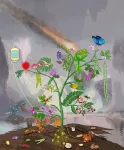The legume family tree
Massive molecular study uncovers clues to the evolution and diversification of essential plant family
2021-05-07
(Press-News.org) The most comprehensive study of the family tree for legumes, the plant family that includes beans, soybeans, peanuts, and many other economically important crop plants, reveals a history of whole-genome duplications. The study also helps to uncover the evolution of genes involved in nitrogen fixation--a key trait likely important in the evolutionary spread and diversification of legumes and vital for their use as "green manure" in agriculture. To reconstruct the family tree, researchers compared the DNA sequence of more than 1500 genes from 463 different legume species, including 391 newly sequenced species, that span the diversity of this large plant family.
A paper describing the study, led by Penn State Professor of Biology Hong Ma, appears in the May 2021 issue of the journal Molecular Plant.
"Legumes make up the third largest family of flowering plants and are incredibly diverse--ranging from tiny herbs to giant trees," said Ma, who is the Huck Distinguished Research Professor of Plant Molecular Biology at Penn State. "They are essential food crops for both humans and livestock, can be used as lumber, and have many other uses. Maybe most importantly, they can 'fix' nitrogen--extracting the vital nutrient from the atmosphere and storing it in nodules on their roots in a symbiotic relationship with soil bacteria--making them important as green manure to improve soil health."
There are over 19,000 species in the legume family divided into six subfamilies and then further divided into narrower and narrower groupings based on their evolutionary relationships. There are 765 genera--the grouping one level above species--of which the team sampled members of 333. To build the family tree, the team analyzed gene sequences from the transcriptomes--the portion of the genome that is expressed as genes--of most of the 463 species and a small number of shallowly sequenced whole genomes from across legume diversity.
"This is the largest study of this kind for a single plant family," said Ma. "We went to great lengths to sample as many species as we could to get a broad representation of the legume family, but it is often difficult to get well-preserved specimens that we can extract DNA or RNA from, especially for species found in remote locations. Having this broad representation of species allowed us to build the most detailed nuclear-gene family tree for legumes to date."
In addition to helping researchers understand the evolution and diversification of legumes, the new legume family tree helps to clarify the relationship between crop plants and their wild relatives. Although the close relatives of important agricultural crops are often known, studying more distant wild cousins could reveal traits that could be exploited to help plants thrive in changing environments and resist diseases or insect pests.
Across the legume family tree, the research team identified strong evidence for 28 separate whole-genome duplication events. Whole-genome duplications, evolutionary events that result in complete duplication of the entire genome, are fairly common among flowering plants and are thought to allow for functional innovation and evolutionary diversification. One of the duplication events that the team identified appears to have occurred in the ancestor of all members of the legume family.
"Because for most of the species in our study we used transcriptomes and do not have entire genome sequences, we consider these as 'proposed' genome duplication events," said Ma. "These kinds of studies are kind of like solving a mystery. If you only have one or a few witnesses it might be difficult to convince a jury of your evidence, but if you have a hundred witnesses who have different perspectives and they all point to the same thing it becomes difficult to dismiss that evidence. In our case, the different species are like our witnesses. The size of our study allowed us to identify events that we might otherwise have dismissed."
The two largest subfamilies account for over 17,000 legume species and include all of the species with the ability to fix nitrogen. Nitrogen is an important plant nutrient--most commercial fertilizers contain a mix of nitrogen, phosphorus and potassium--so the symbiotic relationship between some legumes and the microorganisms that allow them to assimilate nitrogen from the atmosphere using root nodules has spurred their success by allowing them to colonize areas with less fertile soil. The research team also identified clues to the evolution of the genes responsible for this important trait.
"Our data support the idea that nodulation and nitrogen fixation originated a single time early in the history of legumes and other related nitrogen-fixing plants and the whole-genome duplication event at the origin of legumes might have been crucial for the evolution of this process," said Ma. "In addition to this duplication event, we are also able to see gene loss in plants that do not have the ability to nodulate, and evolutionary changes in genes that contributed to their role in nodulation."
INFORMATION:
In addition to Ma, the research team includes Yiyong Zhao, Rong Zhang, Kaiwen Jiang, Ji Qi, Yi Hu, Jing Guo, Renbin Zhu, Taikui Zhang, Ashley N. Egan, Ting-Shuang Yi, and Chien-Hsun Huang. This research was funded by the National Natural Science Foundation of China, the Strategic Priority Research Program of Chinese Academy of the Sciences, the State Key Laboratory of Genetic Engineering, the Ministry of Education Key Laboratory of Biodiversity Science and Ecological Engineering at Fudan University, and Penn State.
[Attachments] See images for this press release:

ELSE PRESS RELEASES FROM THIS DATE:
2021-05-07
With the COVID-19 vaccines on many people's minds, some may be surprised to learn that we do not yet have vaccines for many common infectious diseases.
Take salmonella, for example, which can infect people through contaminated food, water and animals. According to the World Health Organization, non-typhoidal salmonella infection affects more than 95 million people globally each year, leading to an estimated 2 million deaths annually. There is no approved vaccine for salmonella in humans, and some strains are antibiotic-resistant.
But just as scientists spent decades doing the ...
2021-05-07
For some people, social gatherings can be a time to imbibe. And for some, that can turn into a time to overindulge. But how do your neighborhood and your social network affect binge drinking?
Along with colleagues at the RAND corporation in Santa Monica, Indiana University researcher Hank Green examined how neighborhood and social network characteristics were related to adult binge drinking. He and his co-authors found that both factors play a role in how much someone drinks, information that can help us better understand binge drinking among adults.
The study was published in the journal Health and Place, indexed in Science Direct and PubMed.
"Adults living ...
2021-05-07
EUGENE, Ore. -- May 7, 2021 -- Long-running archaeological research, boosted by airborne lidar sensing and machine-learning algorithms, finds that Cambodia's Greater Angkor region was home to 700,000-900,000 people.
The sprawling city, which thrived from the 9th to 15th centuries, has slowly revealed its forest-hidden past to archaeologists, but its total population has been a mystery.
The new estimate, made possible by a study designed at the University of Oregon, is the first for the entire 3,000-square-kilometer mix of urban and rural landscape. The findings published May 7 in the journal ...
2021-05-07
The protein, known as NusG, pauses the transcription machinery at specific DNA sequences to facilitate what is called "intrinsic termination" and prevent unwanted transcription that could disrupt cellular function.
A new study, led by Penn State researchers, shows that NusG and the related protein, NusA, together facilitate termination at about 88% of the intrinsic terminators in the bacteria Bacillus subtilis. Understanding this process expands our basic knowledge of this key cellular function and could eventually aid in the development of antibiotics that target and disrupt gene regulation ...
2021-05-07
Boston, Mass. – Sleep disorders are associated with significantly higher rates of health care utilization, conservatively placing an additional $94.9 billion in costs each year to the United States health care system, according to a new study from researchers at Mass Eye and Ear, a member hospital of Mass General Brigham.
In their new analysis, published in the Journal of Clinical Sleep Medicine, the researchers found the number of medical visits and prescriptions filled were nearly doubled in people with sleep disorders such as sleep apnea and insomnia, compared to similar people without. Affected patients were also more likely to visit the emergency department and have more comorbid medical ...
2021-05-07
(Toronto, Friday, May 7, 2021) -- Probing the unique biology of human pancreatic cancer cells in a laboratory has yielded unexpected insights of a weakness that can be used against the cells to kill them.
Led by Princess Margaret Cancer Centre (PM) Scientist Dr. Marianne Koritzinsky, researchers showed that about half of patient-derived pancreatic cancer cell lines are highly dependent or "addicted" to the protein peroxiredoxin 4 (PRDX4), as a result of the altered metabolic state of the cancer cell.
This addiction is vital for the cancer cell's survival, thereby also making it a precise, potential target against the cancer.
Pancreatic cancer is a deadly disease with an overall five-year survival of only eight per cent. Moreover, 36% to 46% of patients who undergo surgery with ...
2021-05-07
Induced bank filtration is a key and well-established approach to provide drinking water supply to populated areas located along rivers or lakes and with limited access to groundwater resources. It is employed in several countries worldwide, with notable examples in Europe, the United States, and parts of Africa. Contamination of surface waters poses a serious threat to attaining drinking water standards. In this context, human pathogenic microorganisms such as some viruses and bacteria, originating from the discharge of wastewater treatment plants, form a major contaminant group. A detailed study at an induced bank filtration site along the Rhine river in Germany has now linked transport of bacteria to seasonal dynamics. Key results of the study show that floods should be ...
2021-05-07
WASHINGTON, D.C. - Peer reviewed by medical experts that included three U.S. government senior scientists and published in the American Journal of Therapeutics, the research is the most comprehensive review of the available data taken from clinical, in vitro, animal, and real-world studies. Led by the Front Line COVID-19 Critical Care Alliance (FLCCC), a group of medical and scientific experts reviewed published peer-reviewed studies, manuscripts, expert meta-analyses, and epidemiological analyses of regions with ivermectin distribution efforts all showing that ...
2021-05-07
The two meters of -stretched- DNA contained in human cells are continuously twisting and untwisting to give access to genetic information: when a gene is expressed to generate a protein, the two strands of DNA are separated to give access to all the machinery necessary for this expression, resulting in an excessive accumulation of coiling that needs to be resolved later. The paper that has now been published by the team led by Felipe Cortés, head of the DNA Topology and Breaks Group at the Spanish National Cancer Research Centre (CNIO), in collaboration with Silvia Jimeno González, professor at the University of Seville ...
2021-05-07
Neonatal hypothermia -- which occurs when an infant's core body temperature falls below the normal range needed to maintain health -- contributes to approximately one million deaths each year, and countless cases of stunted growth, almost exclusively in low- and middle-income countries. To address this common but preventable condition, researchers from Boston Children's Hospital, engineers at Lawrence Berkeley National Laboratory, and colleagues in Rwanda developed the Dream Warmer, a low cost, reusable non-electric infant warmer to prevent and treat hypothermia. A new study from the team shows that infants who received treatment with the warmer had only an 11 percent rate of ...
LAST 30 PRESS RELEASES:
[Press-News.org] The legume family tree
Massive molecular study uncovers clues to the evolution and diversification of essential plant family




